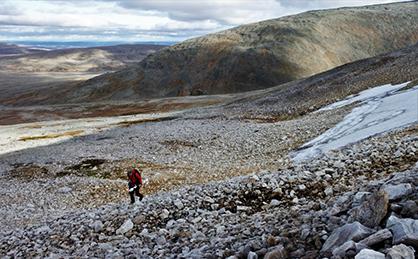Harsh environments remain poorly sampled

Credit: Julia Kemppinen
Global warming is driving rapid environmental change in the Arctic. “To understand these changes, field measurements that adequately represent environmental variation across the Arctic as a whole are crucial”, says PhD student Anna-Maria Virkkala from the University of Helsinki.
A new study by researchers from University of Helsinki and Lund University shows that northern Arctic regions remain under-sampled and provides detailed maps of potential new sampling locations for each environmental science discipline across the Arctic.
The changing Arctic requires a sampling strategy for the future
Doing field work in the harsh Arctic conditions is not easy. Resources and accessibility strongly constrain Arctic research. Understanding what kind of conditions and regions remain under-studied is important when researchers plan new field campaigns.
However, studies dealing with the representativeness of sampling have been conducted mainly for very specific fields, or in smaller regions. Thus, the current state of field sampling across broad environmental science disciplines across the Arctic has not been fully understood.
A literature database and open spatial data sets as a tool to map the representativeness of sampling
“We utilize an existing literature database of around 1 800 field studies across the Arctic”, says Dan Metcalfe, a senior lecturer in Lund University. This database contains information about the field sampling locations and citations, including their primary discipline/s within environmental sciences featured in the article.
Open spatial data sets describing topography, vegetation, and soils were used to characterize the environmental conditions of each sampling location. “The availability of these data sets has increased during the past decade which allows us to explore the environmental coverage of Arctic field sampling comprehensively”, says a Post-Doc researcher Hakim Abdi from Lund University.
New field studies are needed in the northernmost Arctic regions
The study shows that more research is needed particularly in the Canadian Arctic Archipelago, northern Greenland, northern Taimyr, and central and eastern Siberia. These under-sampled regions are characterized by cold soils and climate and modest vegetation cover. Many of these regions are predicted to experience rapid permafrost thaw and vegetation shifts due to global warming in the future. The lack of data from these conditions suggests that we do not necessarily understand the whole range of changes that the global warming might cause.
Differences in sampling across environmental science disciplines
There are differences in the representativeness of sampling locations across environmental science disciplines. Sampling locations in Botany and Biogeochemistry cover environmental gradients the best, and Microbiology, Meteorology, Geosciences and Geographic Information Systems / Remote Sensing / Modeling have the largest research gaps across the Arctic. Although northern Alaska and Fennoscandia remained the best sampled regions, research gaps were found even in central Arctic Alaska or southern Arctic Fennoscandia in some disciplines.
Let’s keep exploring the Arctic together
Luckily, many of these under-sampled regions are close to existing infrastructure (https:/
###
Reference: Anna-Maria Virkkala, Hakim Abdi, Miska Luoto and Dan Metcalfe. Identifying multidisciplinary research gaps across Arctic terrestrial gradients. Environmental Research Letters. doi.org/10.1088/1748-9326/ab4291
Literature database and the maps: https:/
Contact: Anna-Maria Virkkala, [email protected], +358 503116183
Media Contact
Riitta-Leena Inki
[email protected]
358-504-485-770
Original Source
https:/
Related Journal Article
http://dx.




